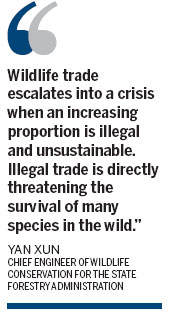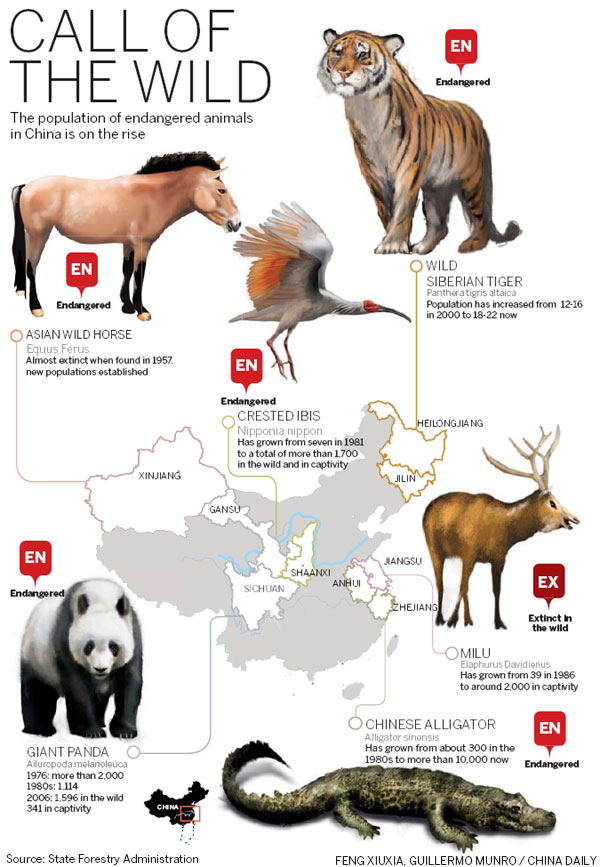Endangered lists enjoy healthy rises in numbers
Updated: 2013-05-22 07:49
By Yang Yao (China Daily)
|
||||||||
|
A Chinese alligator is put into a crate before being released at a local nature protection area on April 15 in Changxing county, Zhejiang province. A total of 120 Chinese alligators have been returned to the wild. Xu Yu / Xinhua News Agency |

Huge investment in new nature reserves starts to pay dividends
The population of China's endangered animals, including giant pandas and Siberian tigers, is on the rise thanks to billions of yuan in investment, a top official from China's wildlife watchdog said on Tuesday.
"The declining trend has been reversed," said Yin Hong, deputy director of the State Forestry Administration.
The latest wildlife census shows the number of wild Siberian tigers has risen from 12 to 16 in 2000 to 18 to 22, while just seven crested ibis were found in 1981, compared to the more than 1,700 that now live in the wild and in captivity.
"One reason for the increase is the growing area of natural reserves," Yin said. "Now 85 percent of protected wildlife lives in 2,150 nature reserves, taking up 13 percent of land in China.
Fan Zhiyong at the World Wide Fund for Nature said the increase in Siberian tigers is due to the fact their habitats are better preserved and their stocks of prey have recovered.
"The tigers have been recorded more frequently by the WWF and forestry bureau workers," Fan said. "At one forest farm in Jilin province, the wildlife watchdog captured photographs and videos of the tigers more than 20 times, three times more than the past three years."
In general, Yin added that the turnaround is also thanks to the wildlife monitoring and prevention system built to control diseases.
She said there are now 350 national, 768 provincial and a great number of county monitoring stations, as well as nearly 10,000 monitoring points and patrol routes. "These monitoring points and patrol routes effectively monitored migrant birds during the H7N9 epidemic, checking for the virus," she said.
Conservation efforts, however, can easily be undermined by habitat destruction, illegal poaching and consumption of wild animals, Yin said.
For many years, NGOs, campaigners and media have accused corporations of being a major source of environmental problems, affecting wildlife habitats.
The Wetland Protection Regulation, which took effect on May 1, forbids mining or polluting activities by corporations in nature reserves, to better protect endangered species.
"Wildlife trade escalates into a crisis when an increasing proportion is illegal and unsustainable," said Yan Xun, chief engineer of wildlife conservation for the State Forestry Administration. "Illegal trade is directly threatening the survival of many species in the wild."
Illegal wildlife trade such as poaching elephants for ivory and rhinos for their horns have been criticized for causing animal numbers in Africa to drop.
Besides these well-known examples, Yan said, countless other species are similarly overexploited, from marine turtles to timber trees. "This demands stronger law enforcement," he said.
Last year, more than 10,000 wildlife crime cases were investigated in China.
For international wildlife crimes like illegal ivory trading, Yan urged a global joint effort.
The Chinese government led a month-long clampdown on wildlife crime earlier this year, dubbed Cobra. It brought together police, customs and wildlife officers from 22 countries in Asia, Africa and North America.
Through the operation, 6.5 tons of ivory, 1.6 tons of Tibetan antelope hides, 22 rhino horns, 10 tiger hides, as well as other protected animal and plant species and products derived from them, were confiscated.
Yan said not all trades are illegal. Wild plants and animals from tens of thousands of species are caught or harvested from the wild and then sold legitimately as food, pets, ornamental plants, leather, tourist ornaments and medicine.
"There is a huge difference between the legal and illegal ones," said Yan.
He said illegal wildlife consumption and trading is a result of the public lacking protection awareness.
"Animal rights organizations and activists can play a role in educating the public and supervising illegal activities," Yan said.
A large number of animal protection activities were carried out by NGOs and green activists. Deng Fei, a former journalist now better known for her role as an animal rights activist, has started major migrant bird rescue activities nationwide, raising public awareness.
"The public should be more aware of the importance of protecting these endangered species and sustaining the ecosystem," said Fang Dan at Animals Asian Foundation.
"We hope to make a difference, through our efforts, in influencing policymaking and arousing public awareness."
yangyao@chinadaily.com.cn

(China Daily 05/22/2013 page7)

 Michelle lays roses at site along Berlin Wall
Michelle lays roses at site along Berlin Wall
 Historic space lecture in Tiangong-1 commences
Historic space lecture in Tiangong-1 commences
 'Sopranos' Star James Gandolfini dead at 51
'Sopranos' Star James Gandolfini dead at 51
 UN: Number of refugees hits 18-year high
UN: Number of refugees hits 18-year high
 Slide: Jet exercises from aircraft carrier
Slide: Jet exercises from aircraft carrier
 Talks establish fishery hotline
Talks establish fishery hotline
 Foreign buyers eye Chinese drones
Foreign buyers eye Chinese drones
 UN chief hails China's peacekeepers
UN chief hails China's peacekeepers
Most Viewed
Editor's Picks

|

|

|

|

|

|
Today's Top News
Shenzhou X astronaut gives lecture today
US told to reassess duties on Chinese paper
Chinese seek greater share of satellite market
Russia rejects Obama's nuke cut proposal
US immigration bill sees Senate breakthrough
Brazilian cities revoke fare hikes
Moody's warns on China's local govt debt
Air quality in major cities drops in May
US Weekly

|

|








